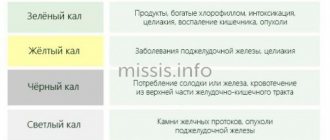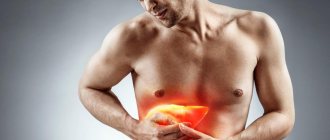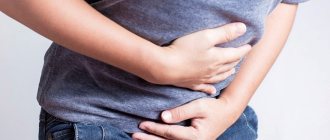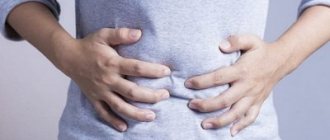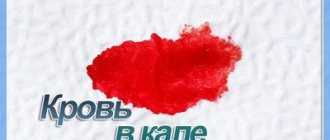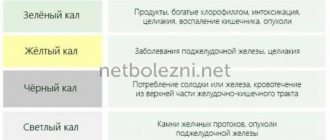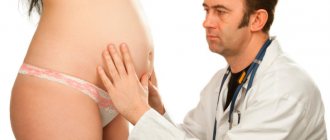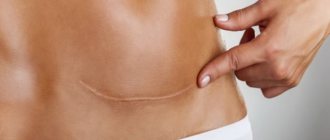Almost everyone is familiar with lumbar pain. They can occur at any age, occur periodically, be associated with a specific pathology or not related to the disease. For example, pain in the lower back can be caused by too intense and strenuous training, or if a person tore his back while working in the country, was in a sitting position for a long time, caught a cold or was in a draft. But there is a condition that will almost certainly cause lumbar pain in the female part of humanity - pregnancy and childbirth. Postpartum nagging pain in the lower back has several causes.
Lower back pain after childbirth
When is this considered normal?
The main cause of pain is the increased release of oxytocin into the blood, which is responsible for uterine contractions and breast milk production. The opening of the cervix is necessary to expel the fetus, and after the placenta is separated, the vessels of the uterine walls bleed heavily. Activation of platelets is not enough for hemostasis, so the body provides increased production of the hormone. This helps stop the bleeding, but causes a feeling of cramping pain in the abdomen. Its intensity weakens towards the end of the first week after birth. In multiparous women, the period lasts longer, since the tone of the uterus is weaker.
Definition of oxytocin
There are a number of physiological reasons when the lower abdomen hurts a week after childbirth:
- Lactation. When the baby sucks, stimulation of the nipples occurs, which is accompanied by the production of oxytocin. With each feeding, the uterus contracts, which causes increased pain.
- Divergence of the pelvic bones caused by the passage of a large child through the birth canal. The woman does not immediately experience discomfort due to the production of relaxin, but after a while pain occurs in the lower abdomen and pubic area.
- A full bladder that puts pressure on the uterus. The presence of cracks and other damage to the birth canal additionally provokes a burning sensation when urinating.
- Tissue and muscle ruptures. After stitches are placed, the stomach hurts until they heal, about 10–14 days.
If the birth took place by cesarean section, then the discomfort is due to the presence of a scar on the uterus. The stomach will hurt for 2-3 months until complete healing. It is important to follow all the doctor’s recommendations - do not lift heavy objects, treat the suture area in a timely manner. To relieve severe pain, analgesics are used, which in small doses do not pose a threat to the child.
Treatment
The uterus has to go through the work of contracting after your baby is born. There is no treatment that will stop it - and you wouldn't want to stop it - but you can ease the cramping and pain you experience to make it a little more comfortable.
- Painkiller. Over-the-counter medications such as ibuprofen may reduce the severity. For particularly painful cramps, your doctor may write a prescription for a short course of stronger painkillers.
- Movement. It may seem unappealing, but getting up and walking around carefully as soon as you can can help relieve postpartum pain.
- Relaxation. Try deep breathing exercises when you are in pain. This will help you get through them and stay calm.
- Heat. Heating pads or hot water bottles may also provide some relief and are easy to find in pharmacies.
- Other offers. Keep your bladder empty if you are breastfeeding, try to do it more often and remember that this too will pass.
If you're constipated, consider taking over-the-counter stool softeners or laxatives to keep things moving. Your doctor or pharmacist can tell you specific medications you can take while breastfeeding.
Lifestyle changes that may help include:
- light exercise;
- a diet high in fiber and plenty of fresh fruits and vegetables;
- drink more water.
Experts recommend drinking 13 glasses of fluid a day if you're breastfeeding.
In case of infections, you need to see a doctor and get a prescription for the appropriate medications. Your doctor may also recommend home remedies to relieve discomfort, such as over-the-counter pain relievers.
Pathological causes
Normally, a woman’s body recovers within a month. If accompanying symptoms appear or pain increases, the gynecologist carries out diagnostic measures to identify possible diseases. There are the following options for pathological causes of abdominal pain after childbirth:
- Remains of the placenta in the uterus. Particles of the embryonic organ contribute to the formation of purulent foci and the development of the inflammatory process.
- Insufficient hygiene of the suture area of the birth canal. The addition of infection contributes to the suppuration of scars.
- Endometritis. The surface of the uterus after childbirth is a continuous wound, so any infection contributes to the development of inflammation of the internal mucosa.
- Peritonitis. The development of the disease is associated with divergence and inflammation of the sutures on the uterus, which contributes to the spread of the process of suppuration into the abdominal cavity.
- Postpartum adnexitis. It is usually one-sided. Occurs when improper treatment or untimely diagnosis of a uterine infection that spreads through the tubes to the ovaries.
- Symphysitis. An X-ray is performed to confirm the diagnosis if the disease is detected in a woman during pregnancy, and there is a history of bone and joint pathologies or multiple pregnancies.
- Intestinal diseases. Changing the diet during pregnancy, breastfeeding, and stress complicate the functioning of the organ. This leads to the development of a number of diseases, the symptoms of which provoke abdominal pain.
“Any complications of postpartum recovery require immediate consultation with a gynecologist.
The development of such pathologies threatens the health and life of the mother. Through diagnosis, the doctor will determine the exact cause of long-term discomfort and prescribe the correct treatment.
What does discharge after childbirth look like at different times?
It is important to pay attention not only to the duration of lochia, but also to their composition. Normally, minor bleeding is observed for the first three days. They appear due to burst blood vessels in the uterus. Over time, the organ cavity heals and bleeding stops.
- In the first week, clots are mixed in - these are pieces of the placenta and dead endometrium.
- On day 12, the lochia becomes liquid and homogeneous. They may be mixed with mucous secretions—remnants of the fetus’s vital activity.
- After a month, lochia looks like brownish smears.
Signs of a pathological process
Pain in the abdominal area, which occurs for a physiological reason, is not accompanied by associated symptoms. The intensity, nature of the pain, as well as the type of additional signs depend on the type of disease. The gynecologist selects treatment taking into account their nature and diagnostic results. If necessary, arrange a consultation with a specialist.
Remnants of placental tissue
Incomplete discharge of the placenta is associated with its partial accretion to the walls of the uterus or manual extraction through the umbilical cord, weak tone, and structural features of the reproductive organ. The diagnosis is confirmed by ultrasound. The following symptoms are considered a prerequisite for its use:
- severe uterine bleeding;
- temperature rise to 37–37.5 degrees;
- general deterioration of health.
What to do with remnants of placental tissue
The problem is solved by curettage under general anesthesia. After the procedure, the woman feels nagging pain for a long time, reminiscent of contractions. This intervention helps prevent the development of infection.
Endometritis
Decreased immunity after childbirth, the presence of chronic pathologies of the genitourinary system, insufficient hygiene of the genital organs, trauma to the perineum and a number of other reasons provoke the development of a bacterial infection. It enters the uterine cavity from the lower genital tract or gastrointestinal tract. In mild cases, nagging pain is accompanied by additional signs of pathology:
- copious bloody-brown discharge from the genital tract;
- increased heart rate up to 100 beats/min;
- temperature rise to 38 degrees;
- a feeling of cold caused by spasm of blood vessels;
- decreased uterine tone.
Inflammation of the uterus
Severe endometritis after childbirth occurs 2–3 days after delivery. The woman complains of headache, weakness, high temperature with chills, poor appetite, sleep disturbance, pain in the abdomen and lower back, and purulent discharge. Any complications of the disease lead to increased discomfort; the development of peritonitis is dangerously fatal, so medical care is provided immediately.
Symphysitis
The main cause of symphysitis after childbirth is increased production of relaxin during pregnancy. Ligaments and joints quickly relax, so the body does not have time to recover quickly. This leads to softening of the bones, high joint mobility, and the development of an inflammatory process of the symphysis pubis. If after childbirth the symphysis does not shrink to its previous size on its own, then after 2–3 days the following symptoms appear:
- discomfort with any movement, increasing at night;
- shooting pain, swelling in the pubic area, pelvis;
- weakness in the legs;
- characteristic clicks when palpating the pubic tubercle or walking.
Divergence of the bones of the symphysis pubis
To confirm the diagnosis, the doctor prescribes an x-ray or MRI, which will determine the degree of discrepancy. During the first stage, there is no pain, so a blood test helps identify the pathology. The second and third are easily detected by palpation.
Placental polyp
In 10% of women in labor, after inadequate removal of the remaining placenta, blood clots adhere to the remaining tissue, which leads to the formation of a polyp. It prevents the uterus from closing completely, so the main symptom is uterine bleeding with clots. Additional signs include nausea, loss of energy, dizziness, pale skin, and low hemoglobin levels.
Polyps in the uterus
The clinical picture usually appears after a month; abdominal pain is a symptom of infection. Ignoring symptoms causes endometritis, ovarian dysfunction, infertility, and sepsis.
Osteochondrosis
The reason when the lower abdomen hurts severely for more than a month after childbirth is often due to osteochondrosis. During pregnancy, weight increases greatly, which contributes to changes in posture. Not all women wear a brace, so the load on their back increases. The nerve endings are compressed, the pain will radiate to the abdominal cavity and lower back. The disease is characterized by the following symptoms:
- lumbago in the lower back, in the groin area, aggravated by lifting weights;
- burning between the shoulder blades;
- decreased sensitivity of the inner thighs;
- disruption of the digestive and genitourinary systems;
- atrophy of the leg muscles.
Osteochondrosis after childbirth
The prerequisites for the disease arise during pregnancy, but it manifests itself mainly after childbirth. It is recommended to follow preventive measures that will remove some of the load from the spine and slow down the development of osteochondrosis.
Intestinal problems
The digestive process in a woman in labor is often disrupted due to the need to exclude a number of foods from the diet. The main cause of pain in the lower abdomen is irritable bowel syndrome, which is accompanied by constipation. The accumulation of feces leads to stretching of its walls, compression of the uterus, which causes discomfort. Women feel spasmodic pain in the gastrointestinal tract, bloating, and flatulence. The clinical picture is enhanced by stress, lack of sleep, and fatigue.
Observation in the postpartum period
After childbirth is completed, the condition of the cervix, vagina and perineum is assessed for each woman in labor. If tears are found, they are immediately stitched up.
In the first few days, the mother is in the maternity hospital under the supervision of doctors. This is extremely necessary, since the vast majority of complications of the postpartum period, such as bleeding associated with poor uterine contractility and incomplete passage of placental tissue, occur in the first days after birth.
In the maternity hospital, mother and baby are monitored daily by a doctor and midwife. They try to prevent the occurrence of purulent-inflammatory diseases in the newborn and the mother.
The general well-being of the woman in labor, the condition of the uterus, external genitalia, mammary glands, as well as the nature of the discharge must be assessed. Body temperature is checked twice a day, and blood pressure and pulse are measured daily.
If the postpartum period proceeds normally, the newborn is vaccinated with BCG, and the mother and baby are discharged home after 3-4 days. Further observation is carried out by a gynecologist at the antenatal clinic.
For some reason, some mothers think that after the birth of a baby, only the baby needs regular medical care. But this is a wrong opinion!
To avoid numerous health problems, mom also needs to be seen by a gynecologist!
When to see a doctor
If there is severe pain in the lower abdomen that does not go away a month after childbirth, women are advised to consult a gynecologist in order to identify the cause of the discomfort. The development of a pathological process requiring immediate treatment is indicated by the following signs:
- heavy bleeding or spotting that occurs in the middle of the monthly cycle;
- a sharp increase in body temperature up to 39 degrees;
- constant nagging pain in the lower abdomen for more than 2–4 weeks;
- inability to raise legs while lying down;
- absence of stool for more than 3–4 days;
- the stomach hurts like contractions with the release of blood clots;
- “duck” gait, lumbago in the lumbar region;
- signs of intoxication of the body (nausea, vomiting, chills).
If you experience severe pain that is accompanied by uterine bleeding or an increase in temperature, you should call an ambulance. The department will conduct diagnostics and prescribe treatment to normalize the condition.
